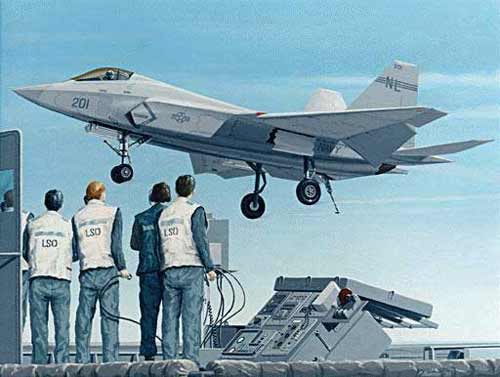X-35 Joint Strike Fighter (JSF)
 Specifications Company- Lockheed Martin
Aeronautics; Northrop Grumman; BAE Systems
Type- Multi-service single-seat, fighter/bomber.
Goals- X-35A first
contractor team full-scale technology demonstrator aircraft intended to
validate technologies relevant to fielding a multi-service aircraft.
X-35B full-scale technology demonstrator aircraft intended to validate
technologies relevant to fielding a multi-service aircraft. X-35C Joint
Advanced Strike Technology (JAST) program full-scale technology
demonstrator aircraft intended to validate technologies relevant to
fielding a multi-service aircraft with catapult and arresting
capability.
Primary Testing Facility
Research- Edwards AFB
Dimensions-
Span- 35 ft, 0 in; Length- 50 ft, 6 in; Height: 17 ft, 4 in
Max Speed-
Mach 1.8
Range- 1,200 nautical miles
Max Altitude-
N/A
Power Plant- One Pratt & Whitney
F135 afterburning turbofan engine and one Rolls-Royce Lift System in
conjunction with Pratt & Whitney F135 turbofan engine
Thrust-
43,000 lbf (Pratt & Whitney F135); 18,000 lbf (Rolls-Royce Lift Fan)
Weights-
Empty: 26,000 lbs; Fully Loaded: 44,400 lbs; Maximum: 60,000 lbs
Payload- Internally mounted single barrel 27-mm Mauser
BK-27 cannon; 13,000 lbs of full range stores including guided weapons,
anti-radiation missiles, air-to-surface weapons, and auxiliary fuel
tanks.
Number of Prototypes Built- 2
Project Tenure-
2000-2002
Project Status- Cancelled
Information The F-35 is the result of the Defense Department's Joint Strike Fighter (JSF) program, which sought to build a multi-role fighter optimized for the air-to-ground role with secondary air-to-air capability. The JSF requirement was to meet the needs of the Air Force, Navy, Marine Corps and allies, with improved survivability, precision engagement capability, and reduced life cycle costs. By using many of the same technologies developed for the F-22, the F-35 has the opportunity to capitalize on commonality and modularity to maximize affordability. The Lockheed Martin X-35 was chosen over the competing Boeing X-32 primarily because of Lockheed�s lift-fan STOVL design, which proved superior to the Boeing vectored-thrust approach. The lift fan, which is powered by the aircraft engine via a clutched driveshaft, was technically challenging but DoD concluded that Lockheed has the technology in hand. The lift fan has significant excess power which could be critical given the weight gain that all fighter aircraft experience. Lockheed Martin developed four versions of the Joint Strike Fighter to fulfill the needs of the Navy, Marine Corps, Army, Air Force and the United Kingdom Royal Air Force and Navy. All versions have the same fuselage and internal weapons bay, common outer mold lines with similar structural geometries, identical wing sweeps, and comparable tail shapes. The weapons are stored in two parallel bays located aft of the main landing gear. The canopy, radar, ejection system, subsystems, and avionics are all common among all different version as is the core engine which is based on the F119 by Pratt & Whitney. Additional systems on the F-35 include: - Northrop Grumman advanced electronically scanned array (AESA) multi-function radar
- Snader/Litton Amecon electronic countermeasures equipment
- Lockheed Martin electro-optical targeting system
- Northrop Grumman distributed aperture infrared sensor (DAIRS) thermal imaging system
- Vision Systems International advanced helmet-mounted display
F-35 VariantsUS Air ForceThe Air Force expects that to purchase 1763 F-35s to complement the F-22 Raptor and replace the F-16 as an air-to-ground strike aircraft. The Air Force variant includes an internal gun, infrared sensors, and laser designator. This is the technologically simplest version of the JSF, in that it does not require hover or aircraft carrier capability. Therefore it does not require the vertical thrust or the handling qualities for catapult launches, augmented control authority at landing approach speeds and strengthened structure to handle arrested landings. At the same time, the Air Force F-35 will have to improve upon the high standards created by the F-16. Since replacement of the F-16 by the F-35 will entail a significant payload reduction, the F-35 faces a very demanding one shot one kill requirement. US NavyThe requirement for carrier operations creates the largest differences between the Air Force and Navy version. The naval version has larger wing and tail control surfaces to enable low-speed approaches to aircraft carriers. Leading edge flaps and foldable wing tip sections account for this increased wing area. The larger wing area also provides the Navy version with an increased payload capability. To support the stresses of carrier landings and catapult launches, the internal structure of this version is strengthened. In addition, the landing gear has longer stroke and higher load capacity, and of course an arresting hook is added. Compared to the F-18C, the F-35 has twice the range on internal fuel.. The design is also optimized for survivability, which is a key Navy requirement. Like the USAF version, the Navy version will incorporate an internal gun and sensors. This new fighter will be used by the Navy as a first-day-of-war attack fighter in conjunction with the F/A-18 Hornet. The Navy plans to purchase 480 JSF. US Marine CorpsThe distinguishing feature of the USMC version of the JSF is its short takeoff/vertical landing capability (STOVL). There will not be an internally mounted machine gun, but an external gun can be fitted. This version requires controllability on all axes while hovering. Another critical design feature is its impact on the ground surface beneath it during hover. The USMC expects their version of the JSF will replace the F/A-18 Hornet and the AV-8 Harrier. The Marine Corps expects to purchase 480 STOVL versions of the F-35. United Kingdom Royal Navy and Air ForceThis version will be very similar to the one procured by the United States Marine Corps. ** Information provided by Federation of American Scientists ** |